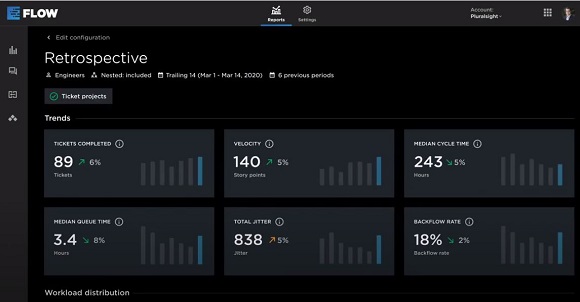Pluralsight Flow widens visibility pipe into developer workflows
In a year of mass disruption to business networks, global & domestic supply chains, information exchange mechanisms (and indeed life itself), many technology vendors have gone to pains to explain how they are focused on delivery mechanisms to make the application point of their core technology propositions more effective.
Utah-headquartered technology skills and engineering management platform company Pluralsight, Inc. is among those using 2020 to further sharpen its toolkit(s).
The company has now announced the introduction of Delivery Module for Pluralsight Flow.
With a heavy emphasis on software developer team collaboration, Pluralsight Flow, delivers software engineering team leaders with a data-driven view into the software development workflows being executed.
Pluralsight doesn’t just want developers to let their team managers know ‘how things are going’ in general terms – instead, it want to facilitate ‘fact-based conversations’ about engineering effectiveness.
Delivery Module then, does what it says on the tin i.e. it’s module of Pluralsight Flow that is focused on software delivery.
In wider terms, this is a tool designed to help engineering teams overcome roadblocks in the software development process and identify improvements.
Jiving with Jira
Pluralsight Flow Delivery Module uses data from Jira to measure the human interactions that occur during the software development process, so teams can understand how they’re progressing against their goals and identify opportunities to optimise collaboration and their workflow.
As readers will know, Jira is a bug and issue tracking and management product originally developed by Atlassian – the company has a limited open source programme of engagement, so Pluralsight’s relationship with this software is most likely on a commercial (paid for) proprietary basis.
In this case, Jira and provides ticket-based analytics configurable to each team’s own unique workflow. This integration gives teams the metrics about how Jira tickets move through their workflows, providing insights into where the time is being spent and where there are breakdowns in the workflow.
“Engineering teams need increased data and visibility into their workflows. Pluralsight Flow delivers these necessary insights, allowing engineers and leaders to see data on the constraints facing their teams and identify how they can best address them. Conversations and efforts can focus on where it matters most, helping teams make changes with real impact,” said Kathryn Murphy, EVP, Pluralsight Flow.
The Delivery Module also provides Retrospective Report (a branded Pluralsight function/product), which takes the form of an analytics dashboard that aggregates metrics based on activity levels, ticket movement and flow efficiency from recent engineering cycles to help engineering teams identify opportunities to improve their processes.
In addition, the dashboard allows engineers and leaders to quickly compare the distribution of work (like bugs vs. new features) against expectations in order to align efforts to priorities.
“Good leaders solve roadblocks and inefficiencies to empower their people. Pluralsight Flow’s Delivery Module broadens the view of the context landscape in a powerful way so we know where we need to focus to improve our workflow,” said Bruce Arnett, SVP engineering, PlanSource.
Scrum masters beat stagnation frustration
Overall here, who is going to complain about visibility, workflow management and the ability for scrum masters to get a better handle on areas where code workflow stagnation (or indeed, plain and simple ticket stagnation) is holding back the drive to get to live production in any software project?
Pluralsight would have been detailing this product development and others at its annual Pluralsight Live developer, user, leader, educator event… but obviously, 2020 had other plans for many of us, here’s looking at 2021.

Image source: Pluralsight



